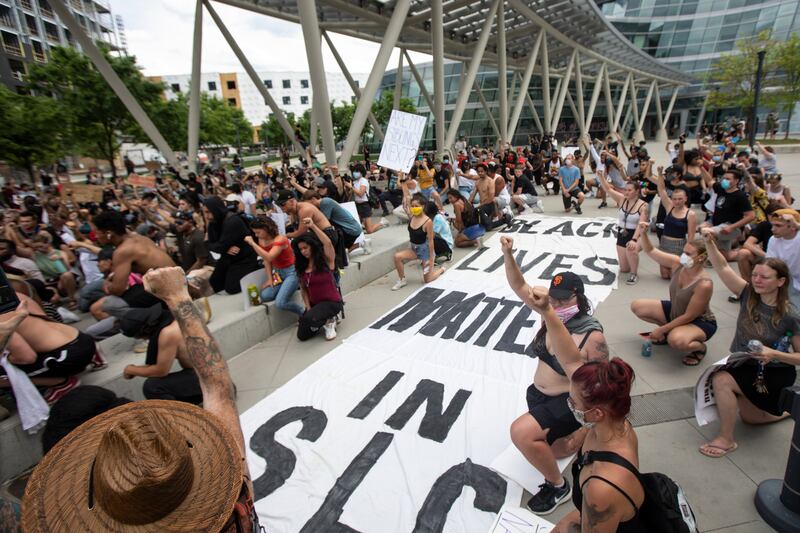When I hear stories about racist acts or comments, I often think, “I know how that feels.” As a biracial person, many have made assumptions about me entirely based on the color of my skin.
But this time is different.
After learning about the details surrounding the murder of George Floyd just a couple short weeks ago, I was horrified to learn that one of the officers on the scene is a Hmong American.
Throughout Asian American communities, that news sparked outrage and conversations about racism within minority groups. In many Asian cultures, colorism and anti-Blackness is not uncommon. It’s time we start addressing it.
In the last few weeks, Asian Americans have been vocal about calling for solidarity with the Black Lives Matter movement and challenging anti-Blackness in their own cultures. For non-Black minorities, the conversations with family and friends about racial inequality and the Black American experience are going to look different. But they’re necessary.
More than ever, it’s necessary for minority groups to support each other. Perhaps Asians especially, whose status as a “model minority” has been used by others as evidence that the system isn’t broken and non-whites have an equal chance to get ahead. First coined as a term more than 50 years ago, “model minority” describes a minority group that is perceived as successful professionally, academically and economically, thereby providing a “model” for other minorities.
In reality, the model minority myth has been used as a wedge between Asian and Black communities for decades. According to scholar and author on political revolutions, race and ethnicity Scott Kurashige, the stereotype of Asians as a “polite” race emerged as the “ideological antidote” to rising civil rights protests from Black communities. While Asian Americans may be the wealthiest minority group, they also have the widest income gap, a result of the difference between highly skilled professional visas and those arriving as refugees. Essentially, a tier of successful Asians exists because they were chosen to.
The same cannot be said for Black Americans, whose history of slavery, segregations, dehumanization and systemic racism was never given the same political turnaround as Asian Americans. In 1966, sociologist William Petersen wrote in The New York Times that “Like the (African Americans), the Japanese have been the object of color prejudice ... The history of Japanese Americans ... challenges every such generalization about ethnic minorities.” His piece solidified and popularized comparisons between the two races that still exist today.
The 1992 riots following the beating of Rodney King exposed the simmering interraccial tensions between Korean Americans and their Black neighbors, ultimately boiling over and resulting in the tragic death of 15-year-old Latasha Harlins by a Korean store owner.
Simply put, Asian Americans have been pawns of the very system that is hurting Black Americans.
To change it, we must first understand where it comes from and examine its manifestation in our own lives.
I reflected on just how many of my own experiences were tinged with — or blatantly focused on — anti-Blackness. I’ve even been told by Filipino friends and family (and ashamedly didn’t speak up against) that I shouldn’t date or marry a Black man so my children wouldn’t be too dark or “aggressive.”
I do not know what it is like to be Black in America. To try and equate my own experiences detracts from the very serious issues they face. While there may be some overlap, there are benefits to my Asian origin that the Black community doesn’t receive.
Not every Filipino or Asian American I know is like this. Several are quite the opposite. But that undercurrent of comparing the minorities and avoiding Black communities has always been evident — and it’s not entirely their fault. Hundreds of years of colonialism, being used as servants and enslaved by white colonizers instilled beliefs of darker skin being inferior, hence the popularity of the skin whitening industry.
Understanding history is the first step in changing the future.
It’s time we started truly looking at the problems of interracial tension, why they exist and how others exploit them.
It’s time to start shifting the trend and amplify other voices instead of criticizing them.
Not changing our behaviors and attitudes disadvantages not only ourselves but future generations by continuing to see other minorities as competition or criticizing them for “taking the wrong approach.”
That form of respectability politics is dangerous and based on a false narrative and false choice. It is not one group against another. Comparison and pedestalizing one culture over another defeats the goal of equity, justice and unity.
This is only the tip of the iceberg. Ample research and information is available on why the model minority myth exists and why it’s important for Asian Americans to speak up. I even helped compile a toolkit of resources for Southeast Asians.
Working together makes an impact. Black American leaders took out a full page ad in 1978 calling for the acceptance of Indochinese immigrants. The multicultural Third World Liberation Front worked together to fight discriminatory college admissions processes, and the famous “Yellow Peril Supports Black Power” poster was popularized in the 1960s.
We are witnessing a historical movement. It’s moved many to start challenging traditional thinking and recognize the role other minorities hold in dismantling systemic and cultural racism and realize that our differences don’t have to divide.
Black voices are the most important in this discussion, but taking a step toward changing our own cultural biases can change the future for all.
Standing together is standing stronger.


